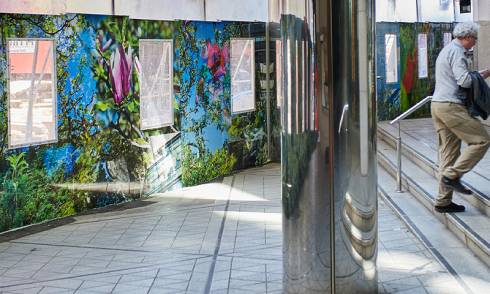Take in the sights of City Rail Link’s Aotea Station construction site with a tour of the artworks installed around the area from a number of leading Aotearoa artists.
Opening in 2024, Aotea Station will be situated in the heart of Auckland’s city centre. The station will be Aotearoa’s busiest train station, with trains running every 10 minutes at peak hour, making travel to the central city much easier and faster than ever before. The City Rail Link project is set to transform the downtown Britomart Transport Centre from a one-way dead-end station into a two-way through-station that will allow the rail network to at least double rail capacity and better connect Auckland for the future with new stations at Aotea, Karangahape and Mt Eden. This is New Zealand’s first underground railway and the country’s largest ever transport infrastructure project.
1 Te Pūkaki information hub
Drop by the information hub Te Pūkaki to find out more about the City Rail Link, the construction activities occurring at Aotea, and upcoming construction milestones. Te Pūkaki is currently located on Victoria Street West at the corner with Elliott Street.
2 Paris Kirby | Cultivate | 99 Albert Street corner
To ‘cultivate’ is to prepare and work with the land, to promote growth and nourishment for the people. Rongo-mā-Tāne is the Māori god (atua) of cultivated plants, especially kūmara. This artwork takes
inspiration from the root vegetable, which forms the basis for the mural’s motif, and Aotearoa’s rich cultural
history of cultivating the land. The artwork invites passers-by to remember the labour and vision that has cultivated our city’s development across time.
3 Jon Tootill | Kākāpō (Night Parrot) | Huawei tower (120 Albert St)
The artwork’s title, Kākāpō (Night Parrot), speaks to a playfulness of colour and patterns of the native bird,
which inform the design for many raranga (weaving/ platting), tukutuku (wall panel weaving) and whakairo
(carving). The colours in the artwork however do not refer to the colours of the native bird, but more to the
colourful and upbeat music of Sir Howard Morrison and Gerry Merito of the Howard Morrison Quartet in the 1950s/60s.
4 Simone Rosenbauer | Like Ice in the Sunshine | Auckland District Court (65 Albert St)
Like Ice in the Sunshine sees the sun shape a mix of paddle pops, with ice becoming liquid, pooling around the melting whole. Colours merge, others separate, some creep away from their body. Flaking, sloughing, gently seeping - each and every one tells a different tale. As bold, quintessentially summertime and as the
elegant images are, they capture a melancholy reality: bitter or sweet, all memories eventually melt into the
flow of life.
5 Blink Boys | River | East Day Spa (123 Albert St)
Drawing inspiration from the Wai Horotiu stream – once central to the area and still running underground today – Blink Boys have created a gradient ‘river’ that runs the length of this space. A gradual colour shift is a nod to the passage of time. The oversized droplets of water reference the historical importance of the area as a body of moving water. It is a visual exploration that connects the past to the present.
6 Deborah Crowe | Urban Mesh | Auckland Council (135 Albert St)
Built from photographic imagery gather during Deborah Crowe’s urban ‘wanderings’ in Tāmaki Makaurau, Urban Mesh fuses references to the past, present, and potential future environmental factors in our urban landscape. A key element embedded in this artwork is the significance of green spaces in the city and the positive impact flora and plant life have on well-being and creating an enriched experience of space.
7 Scott Gardiner | Future Fiction | K3 Legal (83 Albert St)
The sea informs Scott Gardiner’s aesthetic vocabulary. If the ocean is chaotic, raw and untamed, the geometrical forms found within are logical and precise, simultaneously fracturing it, deconstructing it, or else constraining the ocean like cage or a fence, protectively separating viewer and image with an aesthetic distance. Gardiner plays with the sea’s inherent ambiguities of optical depth, push and pull, figurative and abstraction.”
